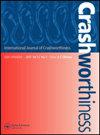Study on the head and neck injury risk impacted by UAV: effect of impact velocity, angle, location, and mass
IF 2
4区 工程技术
Q3 ENGINEERING, MANUFACTURING
引用次数: 0
Abstract
AbstractThe number of the collision accidents between Unmanned Aerial Vehicle (UAV) and people on the ground increase in recent years. It is necessary to clarify human injury characteristics brought by the impact of UAV and promote its management. This study focuses on head and neck injury risk resulted from the impact of the UAV with a relatively large mass, and the difference brought by the UAV with a small mass. First, the model of the Y3-dummy (Hybrid III 50th) is developed. Second, simulations are conducted to analyse head and neck injury characteristics from Y3’s impact under different velocities, angles, and locations. With increasing the impact velocity, HIC and Nij increase with an exponential function and a power function, respectively. When the vertical impact velocity exceeds 5 m/s, both head and neck have a high probability of injury, while for the horizontal impact, the corresponding velocity is 9 m/s. As the impact angle increases, the changes of HIC satisfy the form of the sum of two exponential functions, and Nij changes in the form of the sum of a power function and a quadratic polynomial function. When the impact angle is close to 0°, the head injury risk is relatively high, while for 58°, the neck is more likely to be injury. The injuries induced by the top of mainframe and the front of the long arm are more serious. Finally, the differences in head and neck injury characteristics under different velocities and locations for UAVs with different masses are compared.Keywords: Small UAVdroneimpacthead and neck injuryfinite element analysis Disclosure statementNo potential conflict of interest was reported by the author(s).Additional informationFundingThis study was supported by the National Natural Science Foundation of China (Grant No. 51975041) and the Funding of Ministry of Industry and Information Technology for Civil Aircraft (Grant No. MJ-2018-F-18).无人机对头颈部损伤风险的影响:冲击速度、角度、位置和质量的影响
摘要近年来,无人机与地面人员碰撞事故不断增多。明确无人机冲击带来的人身伤害特点,加强对无人机的管理是十分必要的。本研究重点研究了大质量无人机撞击造成的头颈部损伤风险,以及小质量无人机带来的差异。首先,研制了三号假人(Hybrid III 50)模型。其次,通过仿真分析Y3在不同速度、角度和位置下的冲击头颈部损伤特征。随着冲击速度的增加,HIC和Nij分别呈指数函数和幂函数增长。当垂直冲击速度超过5 m/s时,头部和颈部损伤的概率都很高,而水平冲击速度为9 m/s。随着冲击角的增大,HIC的变化符合两个指数函数和的形式,Nij的变化符合幂函数和二次多项式的形式。当撞击角度接近0°时,头部受伤的风险相对较高,而当撞击角度为58°时,颈部更容易受伤。主机顶部和长臂前部的损伤更为严重。最后,比较了不同质量无人机在不同速度和位置下头颈部损伤特征的差异。关键词:小型无人机撞击头颈部损伤有限元分析披露声明作者未报告潜在利益冲突。本研究由国家自然科学基金(批准号:51975041)和工业和信息化部民用飞机研究基金(批准号:51975041)资助。mj - 2018 f - 18)。
本文章由计算机程序翻译,如有差异,请以英文原文为准。
求助全文
约1分钟内获得全文
求助全文
来源期刊

International Journal of Crashworthiness
工程技术-工程:机械
CiteScore
3.70
自引率
10.50%
发文量
72
审稿时长
2.3 months
期刊介绍:
International Journal of Crashworthiness is the only journal covering all matters relating to the crashworthiness of road vehicles (including cars, trucks, buses and motorcycles), rail vehicles, air and spacecraft, ships and submarines, and on- and off-shore installations.
The Journal provides a unique forum for the publication of original research and applied studies relevant to an audience of academics, designers and practicing engineers. International Journal of Crashworthiness publishes both original research papers (full papers and short communications) and state-of-the-art reviews.
International Journal of Crashworthiness welcomes papers that address the quality of response of materials, body structures and energy-absorbing systems that are subjected to sudden dynamic loading, papers focused on new crashworthy structures, new concepts in restraint systems and realistic accident reconstruction.
 求助内容:
求助内容: 应助结果提醒方式:
应助结果提醒方式:


